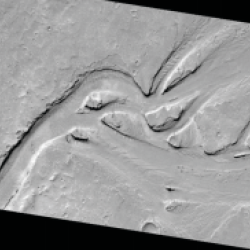Source Institutions
Source Institutions
Add to list Go to activity
Activity link broken? See if it's at the internet archive

In this activity, learners create channel features with flowing water, comparing their observations to real images of Mars and Earth taken by satellites/orbiters. Learners' observations of the ways in which flowing water alters the surrounding terrain are used as clues to draw conclusions about Mars’ geologic past and its ability to support life, as well as how scientists view these features from space.
This activity is part of a 60-minute set of activities in which learners, ages 8–13, explore and compare the features of Mars and Earth, discuss what the features suggest about the history of Mars, and create a model to help them understand how scientists view and study other worlds--like Mars. The activities help to show why scientists are interested in exploring Mars for evidence of past life, and address the question: "Why are we searching for life on Mars?"
This activity is part of a 60-minute set of activities in which learners, ages 8–13, explore and compare the features of Mars and Earth, discuss what the features suggest about the history of Mars, and create a model to help them understand how scientists view and study other worlds--like Mars. The activities help to show why scientists are interested in exploring Mars for evidence of past life, and address the question: "Why are we searching for life on Mars?"
- 10 to 30 minutes
- 10 to 30 minutes
- Over $20 per group of students
- Ages 8 - 14
- Activity, Lesson/Lesson Plan, Model
- English
Quick Guide
Materials List (per group of students)
- 10 pounds of clean playground sand
- 4–5 (1" to 3") rocks (2" diameter or less)
- 4–6 (2-liter) bottles, without lids, filled with water
- access to water to refill the bottles as needed
- 2 plastic wallpaper trays (from home improvement or hardware stores) or other long narrow plastic container such as plastic window planter boxes
- 4 standard bricks (foam floral/craft bricks may be used if desired)
- 2 (5-gallon or larger) trash cans or buckets (rectangular shaped is best)
- 2 large trash bags to line the buckets or trash cans
- 1 set of full-page Earth Image Placemats (stream channel images only) from the Mars Match activity
- 1 set of Mars Cards (channel images only) from the Mars Match activity
- 5 pounds of pesticide-free diatomaceous earth (from a home improvement or pool supply store), gloves, and a mask (optional, recommended)
- 1–2 bottles of craft sand, any color (24 oz. — readily available at hobby or department stores) may be used in place of diatomaceous earth (optional)
- Extreme-O-File: Mars from Above activity pages (optional)
- pencils or pens
- clipboard (optional)
- 1 set of Life on Mars? Trading Cards (optional)
Subjects
-
Earth and Space Science
-
Astronomy
- Probes, Satellites and Spacecraft
-
Earth Structure
- Rocks and Minerals
- Oceans and Water
-
Earth's History
- Geologic Time
-
Solar System
- The Planets
-
Astronomy
- Life Sciences
-
Physical Sciences
-
Chemistry
- Chemical Reactions
- Chemistry of Life
- Motion and Forces
-
Chemistry
-
The Nature of Science
-
The Scientific Process
- The Scientific Worldview
- Asking Questions
- Conducting Investigations
- Gathering Data
- Formulating Explanations
- Communicating Results
- Science as a Career
-
The Scientific Process
Informal Categories
- Model Building
- Nature and Environment
Audience
To use this activity, learners need to:
- see
- read
- touch
Learning styles supported:
- Involves teamwork and communication skills
- Involves hands-on or lab activities
Culture, ethnicity, and gender
-
Girls
- Explicity developed for this group
- Uses inclusive images of people from this group
Other
Components that are part of this resource:
Includes alignment to state and/or national standards:
This resource is part of:
Access Rights:
- Free access
By:
Rights:
Funding Source:
- NASA, NNH09ZDA001N–EDUC
